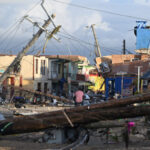Prior to 2004, Florida had gone for five years without a significant hurricane. So it is of little surprise that the onslaught of this year’s three major hurricanes has caught all of us in the insurance industry a bit unprepared. After all, Mother Nature does not always cooperate with our plans.
The severe battery and devastation of Charley, Frances and Ivan is something the claims industry has not seen in modern times and may very well be a critical turning point for how claims processing and handling will be dealt with in the future.
Hurricane Charley charged ashore on Florida’s southwestern coast in mid-August with 145 mph wind and 10-foot waves. It left behind the worse damage since Andrew and the insurance industry’s response was swift and according to plan.
Adjusters used GPS navigation and communication systems to locate their clients in the absence of phone lines and road signs. Insurance companies quickly called in teams of civil, structural, mechanical and electrical engineers to issue reports and help get people’s lives back in order. We were immersed with analyzing the damage and helping people understand why the state building code rewarded some and failed others. But then – just as soon as the process was up and running smoothly – we were looking behind our backs as Hurricane Frances approached only a few weeks later.
While most of Charley’s commercial claims had already been addressed, many outside adjusters and investigators were forced to pull out of Florida, concerned about their own safety and well-being – forcing homeowners still suffering to simply wait out the next storm.
With Frances surfaced a different set of problems – as the heavy winds of Charley were replaced with the heavy rainfall of a large slow-moving storm that battered buildings for extended periods of time. The eye of Frances was huge, encapsulating some of the same areas hit by the first hurricane. The temporary tarps fastened as replacement roofs were ripped off as Frances barreled through Florida. The wide eye of the storm forced the insurance industry to face another unexpected problem, as the homes of local adjusters’ became victims of the storm as well.
And then, just as we all prepared to get back to work, the promise of yet another hurricane set off panic in the state of Florida. Hurricane Ivan’s impending arrival generated a whole new headache – gas shortages – and stranded insurance workers both inside and outside the state. Without a means of reliable transportation, we were forced to wait for Ivan to arrive – hoping the residents of Florida would exercise patience as they waited for claims assistance.
As with others, our team of investigators was able to re-enter Florida on the heels of Ivan, setting up multiple operations around the state with more than two-dozen civil and structural engineers. While we have an excess of manpower, some small insurance companies are struggling to find the adjusters to address the claims generated by three consecutive hurricanes. It may be months from now before the actual turmoil of the immense number of claims surfaces and can be addressed.
Although Mother Nature generated most of the challenges outlined above, there are some issues that the insurance industry may need to evaluate moving forward:
* Many CAT adjusters relocated during recent years, due to falling wages and dwindling catastrophe work – leaving Florida without the manpower needed. Temporary staff may solve this problem in the future.
* The industry must be more flexible. It simply cannot continue to be as rigid in how organizations are financed, how issues are handled and the availability of reinsurance.
* Even the most unlikely events needs to have a plan – think the unthinkable.
The triple hurricanes have left most of us shaking our heads. With the industry already stretched to the breaking point, insurance companies will need to quickly locate enough individuals to handle claims in a timely manner and prepare to handle similar disasters in the future.
Additionally, these adjusters must be able to address complicated building and code issues that can greatly affect the outcome of any claims settlement. The failure to properly evaluate and consider these issues during the early stages of the claims process can lead to even greater problems in the months to come.
Dan Heyer is vice president of Engineering for Engineering and Fire Investigations (EFI), a provider of environmental, engineering, fire investigation, accident reconstruction and testing. During his 32 years in the investigative insurance business, he has worked more than 20 hurricanes and natural disasters. He can be reached at daniel_heyer@efiglobal.com.
Was this article valuable?
Here are more articles you may enjoy.

 Florida And East Coast Will See Big Losses From More Cat 5 Storms, Researchers Say
Florida And East Coast Will See Big Losses From More Cat 5 Storms, Researchers Say  Hermès Heir Sues Arnault and LVMH in $16 Billion Suit Over Lost Shares
Hermès Heir Sues Arnault and LVMH in $16 Billion Suit Over Lost Shares  OpenAI And Microsoft Sued Over Murder-Suicide Blamed on ChatGPT
OpenAI And Microsoft Sued Over Murder-Suicide Blamed on ChatGPT  State Farm Sued Over Policies Backed by Distressed Insurer PHL
State Farm Sued Over Policies Backed by Distressed Insurer PHL 